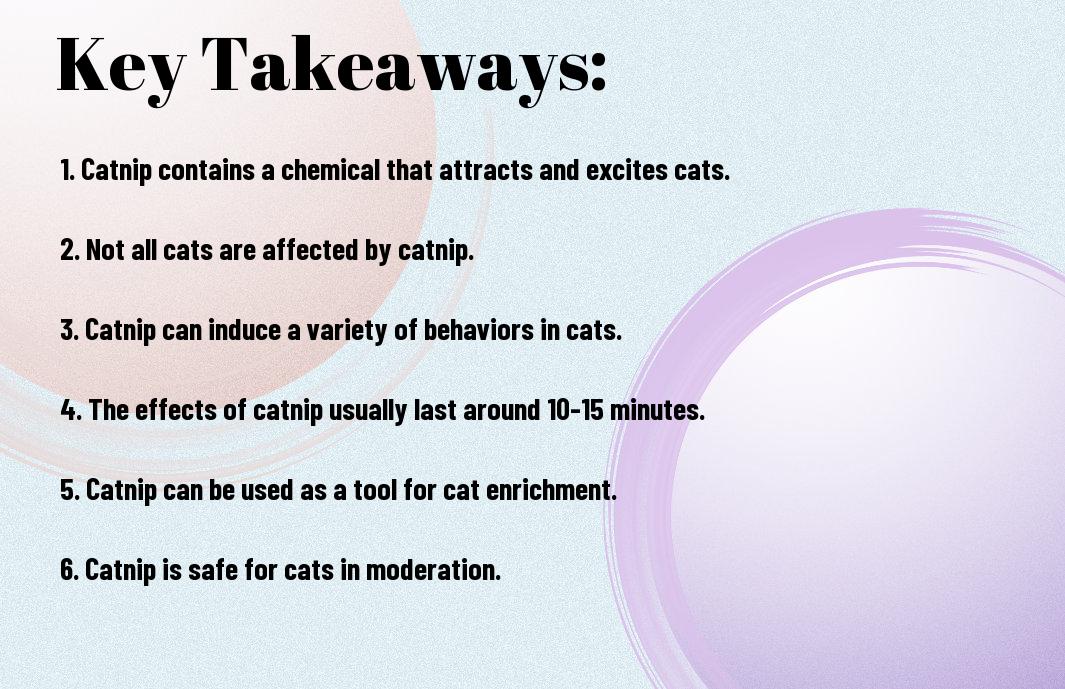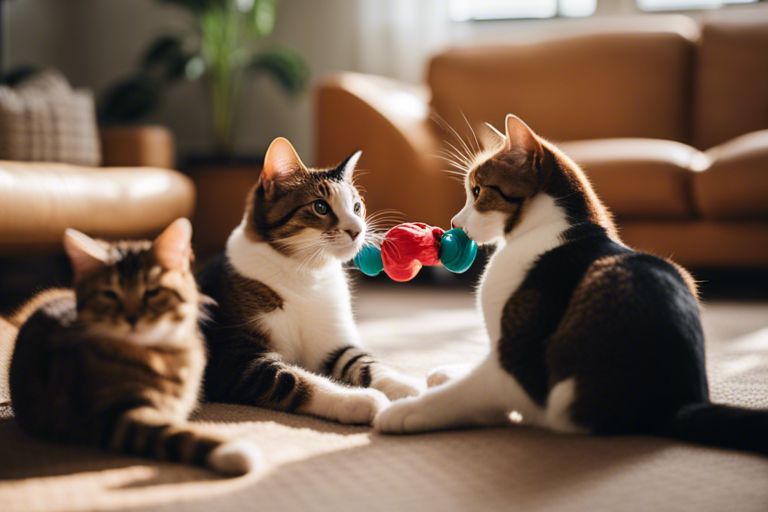Feline enthusiasts have long pondered the enigmatic allure of catnip and its effects on our beloved furry friends. Whether you are a seasoned cat owner or a curious newcomer, understanding the science behind catnip’s effect on cats is essential. In this informative blog post, we will delve into the chemistry of catnip, explore the positive and potentially dangerous effects it has on our feline companions, and provide valuable insights into how to safely introduce catnip to your cat. By the end of this article, you will have a comprehensive understanding of why cats simply can’t get enough of this fascinating herb.
Key Takeaways:
- Catnip reactions are genetic. Cats have specific genes that determine whether or not they will react to catnip, and it is estimated that approximately 50-70% of cats have these genes.
- Catnip can have different effects on cats. While most cats exhibit behaviors such as rolling, rubbing, and licking when exposed to catnip, some may become more aggressive or hyperactive. Additionally, kittens and older cats may not react to catnip at all.
- Catnip is safe for cats. In moderation, catnip is not harmful to cats and can provide mental and physical stimulation. However, excessive exposure may lead to temporary loss of interest in catnip, so it is best to use it sparingly.

Understanding Catnip
Assuming you’ve ever seen a cat reacting to catnip, you might wonder what exactly makes this herb so irresistible to our feline friends. Do cats love catnip because of its smell, taste, or texture? Is there any herb that produces a similar effect in humans? These are some of the questions that might pop up as you start to explore the world of catnip.
What Is Catnip?
For those unfamiliar, catnip is a perennial herb belonging to the mint family. It’s native to Europe and Asia, but is now widespread across the world. The active ingredient in catnip that cats love is called nepetalactone, which is found in the leaves and stems of the plant. When cats come into contact with catnip, whether by smelling, eating, or rolling in it, they often exhibit behaviors that suggest they are having a great time.
Attraction to catnip varies among individual cats, with some showing little to no response. The effects of catnip typically last for about 10-15 minutes, after which the cat becomes temporarily immune to its effects for roughly 30 minutes. It’s worth noting that kittens and older cats may not be as responsive to catnip as adult cats. It’s also interesting to mention that not all cats are affected by catnip—approximately 30% of cats do not experience any behavioral changes when exposed to it.
The Science Behind the Attraction
Attraction to catnip is often attributed to the scent of the nepetalactone compound, which binds to receptors in a cat’s nasal tissue, causing a chemical reaction that triggers a response in the brain. This is why sniffing catnip can lead to a range of behaviors, from purring and rolling to jumping and running around in excitement. For instance, when ingested, catnip can act as a sedative, while sniffing it can produce a stimulant effect, resulting in these distinct reactions in cats.
Effects of Catnip on Cats

Unlike humans, catnip has a profound effect on cats. When exposed to catnip, cats undergo a series of behavioral and physiological changes that are worth exploring in more detail.
Behavioral Responses to Catnip
Catnip can cause a variety of behavioral responses in cats, including rolling, rubbing, purring, and overall excitement. This reaction is thought to be triggered by the compound nepetalactone, which stimulates the receptors in a cat’s nose, promoting a temporary feeling of euphoria. Some cats may also become more playful or exhibit increased vocalization when exposed to catnip.
Health Benefits and Concerns
The consumption of catnip has been known to alleviate stress and anxiety in some cats, much like aromatherapy does for humans. However, it is important for cat owners to ensure that their pets do not consume excessive amounts of catnip, as it can lead to digestive issues such as vomiting and diarrhea. Additionally, some cats may become aggressive or overly hyperactive when exposed to large quantities of catnip.
Any cat owner should use catnip in moderation and observe their pet’s reactions to ensure that they are benefiting from the experience without endangering their health. Keeping a watchful eye on their behavior can provide valuable insight into how the catnip is affecting them.
Catnip Uses and Products
Keep your feline friend entertained and happy with a variety of catnip products available on the market. From catnip sprays and toys to catnip-infused bedding, there are numerous options to choose from to satisfy your cat’s catnip cravings.
Varieties of Catnip and Their Uses
On the market, you’ll find different varieties of catnip, each with its own unique uses. Some catnip toys and sprays contain a more potent form of catnip, appealing to cats who are particularly sensitive to its effects. On the other hand, catnip-infused bedding provides a more subtle and continuous release of the herb, perfect for cats who enjoy lounging in their favorite spot.
Commercial Catnip Products and DIY Ideas
For cat owners who prefer to have more control over the quality and source of catnip, it’s possible to create your own catnip products at home. From homemade catnip sprays to DIY catnip toys, the possibilities are endless. However, it’s important to do thorough research and ensure the safety of any homemade catnip products before introducing them to your feline companion.
Catnip-infused toys and scratching posts are also available in pet stores, providing a convenient way to give your cat the joy of catnip without the hassle of DIY projects.
Alternatives to Catnip
Your feline friend may not be affected by catnip, but fear not! There are a few alternatives that can still provide them with hours of fun and stimulation. While they may not have the same effect as catnip, these alternatives can still bring joy to your fur baby.
Other Plants That Affect Cats
Affect your cat’s behavior in a similar way to catnip. Some common alternatives to catnip include valerian, silver vine, and honeysuckle. These plants can trigger a similar response in cats, causing them to exhibit playful and energetic behavior.
Tips for Cats Unaffected by Catnip

For cats that are unaffected by catnip, there are still ways to ensure their playtime is enjoyable. Introduce new toys and activities to keep them stimulated, such as interactive puzzle feeders and feather toys.
- Introduce new toys
- Engage in interactive playtime
- Provide enrichment opportunities
Assume that your cat may still have a lot of fun without the need for catnip.
For instance, you can introduce new toys to keep your cat engaged and stimulated.
- Introduce new toys
- Engage in interactive playtime
- Provide enrichment opportunities
Assume that even without a reaction to catnip, your cat can still lead a fulfilling and playful life with the right stimulation.
Can Catnip Help Reduce Stress and Aggression in Mother Cats?
Catnip, known for its calming powers, offers intriguing benefits beyond mere play. Some studies suggest that mother cats benefit from catnip’s soothing effects, potentially easing stress and reducing aggression—concerns paramount when considering mother cats eating kittens facts, highlighting instinctual yet disturbing behaviors under duress.
Why Do Cats Love Catnip? Everything You Need to Know.
Now that we’ve explored the fascinating world of catnip and its effects on our feline friends, it’s clear that this herb holds a special power over cats. From its appeal to their sense of smell to its role in stimulating their natural behaviors, catnip has been a long-standing mystery in the world of pet care. Understanding the science behind catnip can also help pet owners make informed decisions about how to best incorporate it into their cat’s environment. As we continue to learn more about this intriguing plant, we can ensure that our pets are happy and healthy while enjoying the playful effects of catnip.
FAQ
Why do cats love catnip?
Cats love catnip because it contains a compound called nepetalactone, which activates sensory receptors in their brains, resulting in feelings of euphoria and playful behavior.
Is catnip safe for cats?
Yes, catnip is safe for cats to consume. However, excessive ingestion can lead to vomiting and diarrhea, so it’s best to limit their access to it.
How can I give catnip to my cat?
Catnip can be given to cats in various forms, such as dried leaves, sprays, or infused toys. You can sprinkle a small amount on their scratching post or toys, or give it to them as a treat.
Can kittens have catnip?
Kittens under six months old typically do not react to catnip, as the sensitivity to nepetalactone is hereditary and only develops with age. Most cats develop a reaction to catnip by the time they reach six months of age.
How often should I give catnip to my cat?
It’s best to limit a cat’s exposure to catnip to once every 1-2 weeks to prevent them from becoming desensitized to its effects. This will ensure that they continue to enjoy the stimulating effects of catnip over time.

Hello there, I am Iftekhar Ahmed. I am the owner of Mishka & The Cat Corners. I love to explore and write on various topics about cats

